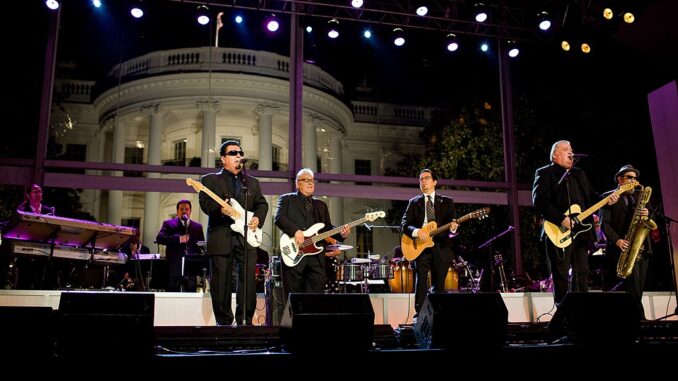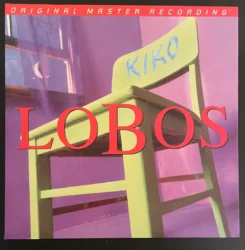
Los Lobos burst onto the music scene in relatively modest ways in 1973 in East Los Angeles with vocalist and guitarist David Hidalgo and drummer Louie Perez having met at high school. Their success, though, took a long time – their debut album was recorded in 1977 to little public notice. After an EP released by Slash Records/Warners, it wasn’t until the release of their major label debut “How Will The Wolf Survive?” that critics and the public alike finally took notice.
Over their fifty-two-year career, they have released seventeen albums and achieved chart success with the track ‘La Bamba’ from the 1987 film. They have always ploughed their very own furrow, and their albums have gained some serious critical acclaim. With a back catalogue as strong as theirs, it seems churlish to nit-pick and single out any ‘lesser’ releases, but there is one album that, to these ears, was a little more caustic than the others.
Their previous album, “Kiko” (more of that soon), was released four years earlier, and for various reasons, the band went silent, sort of. They had various side projects to work on, including The Latin Playboys.
A quick aside – if you’ve never heard it, do try and track down the 1999 album “Houndog”, a collaboration between Hidalgo and Mike Halby from Canned Heat. It’s a truly magnificent blues/americana album and is one of Tom Waits’ favourite albums.
Can’t Live With It: “Colossal Head” (1996)
 So this was the band’s eighth studio album and was released on Warners with their tried and trusted producer Mitchell Froom once again twiddling the knobs, with assistance from Tchad Blake.
So this was the band’s eighth studio album and was released on Warners with their tried and trusted producer Mitchell Froom once again twiddling the knobs, with assistance from Tchad Blake.
It opens with ‘Revolution’, a blues rock track which isn’t the most impactful and is followed by an equally edgy ‘Mas Y Mas’ with a stream-of-consciousness set of lyrics sung by Hidalgo in Spanglish. ‘Maricela’ is sung in Spanish and is a lovely tune emboldened by conga and synths. ‘Everybody Loves a Train’ is a spoken/sung song which sounds mean and moody – it’s got a great Los Lobos feel but doesn’t quite work. Another track that sounds distinctly odd is the title track: both of these have the requisite off-kilter feel that’s the band’s trademark, but there’s something lacking.
The album is experimental and a lot of fun but it didn’t sell at all well, and Warners dropped the band after this release, which was a major challenge for the band. They bounced back with a new label in Mammoth, and some fantastic work to date.
Can’t Live Without It: “Kiko” (1992)
 So, four years before “Colossal Head”, the band released their sixth album and this, with the exception of “La Bamba”, sold more units than any other album in the band’s entire history. It was voted album of the year by Los Angeles Times and Chicago Sun-Times.
So, four years before “Colossal Head”, the band released their sixth album and this, with the exception of “La Bamba”, sold more units than any other album in the band’s entire history. It was voted album of the year by Los Angeles Times and Chicago Sun-Times.
The backdrop to this album was that leading up to this, the band were in mini-crisis mode. A combination of losing money touring a big live show and becoming disillusioned by the typical music business demands, they’d hit rock bottom. Saxophone keyboard player Steve Berlin commented – “We felt like we had been sold a bill of goods and we’d made mistakes, and we just had this attitude, kind of angry — angry at ourselves, the attitude was, “We’ve got nothing to lose, let’s just do whatever we want to do”.”
Producer Mitchell Froom won a Grammy nomination for his work on this album. Going into its production, the bosses at Warners suggested that the band “take a creative leap.” And what a leap that was. So the band drew on all its multifarious influences, including blues and zydeco, mariachi, classic rock, Motown soul, country, tex mex and 1940s big band jazz.
Opener ‘Dream In Blue’ starts as it means to continue – brilliant songwriting, really strong vocals and a stunning wide range of instruments played to perfection. The band also wrote songs with challenging themes, the scourge of homelessness (‘Angels With Dirty Faces’); the horror of rape (‘Reva’s House’) and the blight of alcoholism (‘Whiskey Trail’).
One of the most celebrated songs ‘Kiko and the Lavender Moon’ is truly sublime. As Mitchell Froom described it “it’s Duke Ellington meets The Three Blind Mice.” It’s built on an old-fashioned Latin groove and shows just how bold and inventive the band were being with this newfound creative freedom.
Another example of the superb songwriting is ‘Short Side Of Nothing’, a Hidalgo/Perez tune that’s affecting, tender yet tough and has a truly memorable tune. ‘Riva’s House’ is a cracking Louie Perez tune that was sparked by a story by a Southern writer named Reese Dejapancake, who took his life when he was 26 years old. He had a story with a character called Reva, who Perez saw as an alcoholic. Perez himself had been in recovery for four years. It’s a classic Los Lobos song.
‘Saint Behind The Glass’ is another astounding Perez song, taking him back to his childhood where he, his mother and sister slept in a single room, and at night, Perez watched this religious figure his mother had in a glass in the bedroom, which mesmerised him. These childhood memories are the backbone to another memorable track from this mould-breaking album.
There are sixteen tracks on “Kiko” and it sounds as amazing today as it did back in 1992. As Steve Berlin says – “When we went into the studio for “Kiko”, the mindset was really: “What do we have to lose? Let’s do it the way that we want to do it; let’s make ourselves happy – and if this is the end, then at least we went out with our boots on”.”


